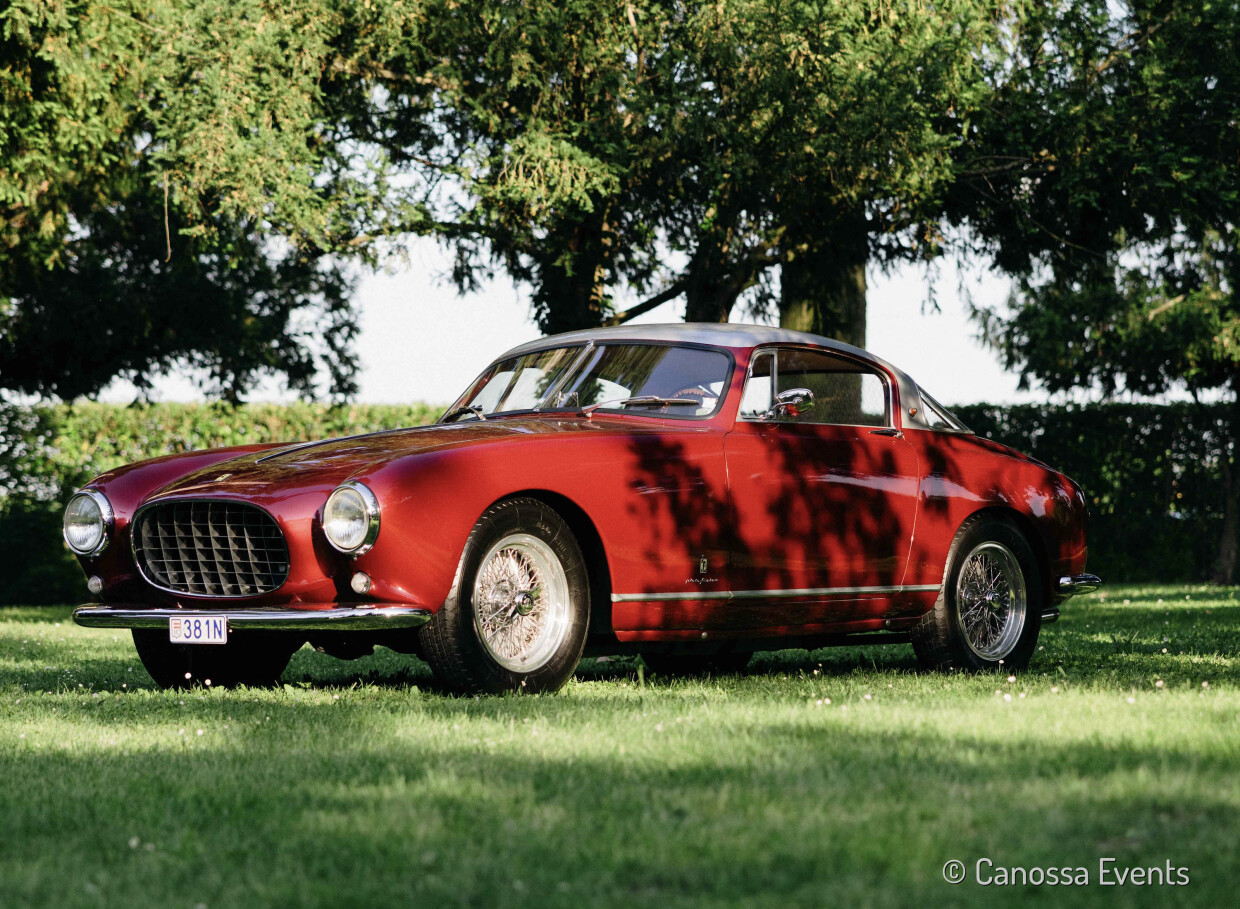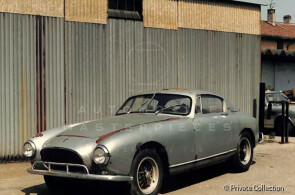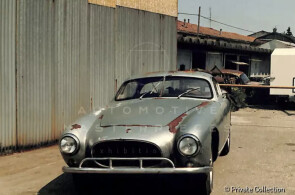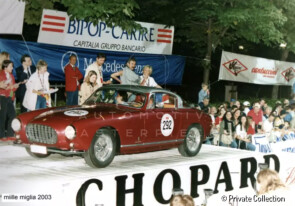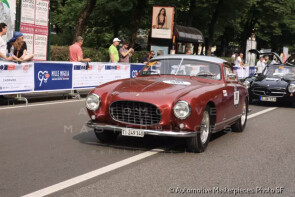
1955 Ferrari 250 europa GT
ON/OFF
Why am I an Automotive Masterpiece?
The Ferrari 250 is a series of sports cars and “granturismo” built by Ferrari from 1952 to 1964. The company's most successful early line, the 250 series includes many variants designed for road use or sports car racing. 250 series cars are characterized by their use of an engine designed by Gioacchino Colombo, with the exception of the 250 Europa. This engine was the “Tipo 125” with a displacement of “just” 2953 cc, but it was light and powerful. The 250 series was replaced by the 275 and 330 series cars.
The 250 europa GT is a sports car built by Ferrari in 1955. It was presented at the 1954 Paris Motor Show and replaced the 250 Europa. In the beginning it was called "250 Europa" too, but later "GT" was added to distinguish the two series. They were two very similar models, and the most important aesthetic difference was the distance between the front mudguard and the windshield pillars. It was also similar to 375 America. However, what mostly distinguished the two models was the engine. The "250 Europa" was equipped with a "long" V12 engine designed by Aurelio Lampredi, while the "250 europa GT" had installed a "short" V12 conceived by Gioachino Colombo. Thanks to the shortening of the engine size, it was possible to shorten the wheelbase by 200 mm to a total of 2600 mm, without however reducing the space in the passenger compartment. The track width was increased. Another element that distinguished the "250 europa GT" from the "250 Europa" was the chassis. The latter on the "250 europa GT" consisted of two main tubes positioned longitudinally, with transverse cross-shaped reinforcements and external supports on which the bodywork was mounted. These main tubes of the chassis passed over the rear axle and not below. The 3 litre engine was a front- mounted longitudinal 60° V12. It had a displacement of 2963.45 cm3 with bore and stroke of 68 mm. The compression ratio was 8:1. It was fed by three Weber 36 or 42 DCZ double-barrel carburettors. The distribution was SOHC with two valves per cylinder. The spark was single with two distributors. Lubrication was wet sump while the clutch was double disc. The power output was 200 hp at 6300 rpm. There were many difference between the "long" engine of the 250 Europa (Lampredi) and the "short" engine mounted on the "250 europa GT" (Colombo). The former had the cylinder liners screwed into the cylinder head, and therefore needed more space. The latter had a more common cylinder liner, inserted with a gasket in the cylinder head, and this led the engine to be more compact. The front suspension were independent, with transversal wishbones, a single transverse leaf spring, later replaced by coil-overs. The rear suspension was live axle, supported by semi-elliptical leaf springs; Houdaille lever hydraulic shock absorbers were on four corners. The gearbox had four synchronized speed and various final ratios, available at the customer's choice. The steering was worm and sector. The brakes were drum on the four wheels with hydraulic assistance. Top speed was around 220 km/h. Almost all models produced were left-hand drive, except for one. The "250 europa GT" was the landmark for the Ferrari road cars that followed, thanks to the homogeneity in its construction. From this model, Pinin Farina became the almost unique designer for the series Ferraris. In addition, modifications to the engine and chassis of this model would have traced the road to Ferrari's road cars for about ten years, under the generation of models of the "250 GT" class. The car was only available by special order, and Ferrari were famously finicky about who they accepted as customers – the 250 was also the very first grand tourer from the Maranello based company.
Chassis 0399GT is one of 28 Pinin Farina’s coupe among the 35 Ferrari 250 europa GT’s built. The owners of these cars were amongst the most influential people in the world. The Ferrari 250 europa GT wasn’t really a production car as each example could have different details. It is assumed that chassis 0399GT, was imported by Joseph “Papa” Cattaneo from St. Cloud, Paris. Cattaneo was an Italian born engineer with French nationality. He actively raced before the war and owned since the late twenties a very reputed garage in Saint-Cloud, a rich Paris suburb. He was specialized in Bugatti and luxury cars, before the war and Ferrari, after the war. He had a personal relationship with Enzo Ferrari since the Alfa Romeo days and was close friend of Luigi Chinetti. He maintained the Ferraris for “very important people”. He also tuned racing Ferraris for top French drivers and the garage was the operating base of Chinetti's NART when racing in Europe. At that time, Joseph Cattaneo was the only mechanic capable of maintaining Ferrari mechanics in Paris, from his workstation in St. Cloud. Mr. Cattaneo had, of course, a buyer. According to the Ferrari factory records it is specified: “0399GT = Mr. Sydney Chaplin, St Cloud”. Sydney Earl Chaplin was Charlie Chaplin's (third) son and was an actor. Sydney made his screen debut in 1952 as the young romantic lead, opposite Claire Bloom, in his father’s film Limelight, but effective though he was, he found few subsequent rewarding roles. The best of them were Treneh in Howard Hawkes’s Land of the Pharaohs and the leading role in a good British thriller, Ken Hughes’s Confession, both in 1955. He had, anyway, a long-lasting career and had, later, a greater success mostly on Broadway. At that time, he was based in his home in St. Cloud near Paris while, engaged in his film career, he found himself shooting in Europe. He was constantly in and out of love. On Land of the Pharaohs he was romantically involved with the female star, Joan Collins; and later the same year, working on Gregory Ratoff’s Abdulla the Great, he embarked on a much-publicised affair with the film’s star, Kay Kendall. A real “bon vivant”, tall, handsome, brilliant and with an important name, he was often captured in the follies of the "dolce vita". His widow, Margaret Beebe, confirmed that Sidney purchased the Ferrari in 1955, during the Italian filming session for Land of The Pharaohs by Howard Hawks. The film was shot in Egypt and in the Titanus studios in Rome. Margaret reports that Sydney “was a wild one in those days… he was getting paid in cash and would drop by the Ferrari shop every pay day… Then he drove it on the roads at full speed when possible”. Ferrari cars were nothing new in the family, since Charlie Chaplin in turn had, at least, two Ferraris. Chaplin moved throughout Europe, speeding his Ferrari to reach the French Cote d’Azur or the Manoir de Ban, his father Charles’ mansion in Corsier-sur-Vevey in Switzerland, where Sidney was a favourite guest of Charlie and Oona O’Neill. While destinations in south France could be the Charlie Chaplin’s holiday home by the Villa Lo Scoglietto in St. Jean Cap Ferrat and the residence in Nice of Sidney’s namesake uncle, Sidney (John) Chaplin: a penthouse suite at the Palais Rosa Bonheur, near the Promenade des Anglais. The relationships between the (many) members of the Chaplin family had remained close over the years; which, at the same time, led Sidney and the other members to move, in Europe but also between the United States and Europe, for many reasons of work, documents, interests and of the family itself. Chaplin sold 0399GT in 1961 following an accident of a cliff and the car was damaged. Since there are no cliffs in St. Cloud it is assumed that an accident occurred somewhere else, but there is no news on where it could have happened; whether on the roads of the French Riviera in France or maybe in Southern California, around Palm Springs, where Sidney resided. In 1961, 0399GT was bought from Chaplin by well-known Italian-American Dominick Spadaro, a go-to man for rare and vintage Italian automobiles. Domenico Spadaro left Sicily to come to New York where he opened his shop and provided impeccable auto service “all’italiana” to the New York Tri state motor community for decades. Dominick's European Car Repair opened in 1961, making it almost sixty years old. Dominick’s sons keep the shop running. A former official Lancia sales point back in the 1960s, the shop in White Plains, New York, has been an old-car mecca since it opened. Dominick was well loved; gracious interaction with the customer was his standard. He tolerated the Americanization of his name Domenico but not operated in the typical American way. Coming of age in war-ravaged Italy, an environment of scarcity where wide-ranging mechanical skills were not just ideal but essential, his bias was to fix, not replace, and to keep the machine running, not throw it away. Locating hard-to-find parts did not upset him. At a time when plugging in modules is most common, making parts remained an option for this gifted machinist and his skilled offspring. More artisan than mechanic, one of the great things about Dominick and the many who've worked their way up in his shop, in the classic European apprentice tradition, was his holistic view of automobiles, the ability to see the interconnection between their many systems. He had no patience for those who fix one thing while ignoring others. Jam-packed with an ever-changing but always mind-bending assortment of older, name-brand thoroughbreds (Ferrari, Alfa Romeo, Maserati), obscure racing machinery (Stanguellini, Dagrada), so-called etceterini (Abarths, ASA, Siata), and so on, the shop is a little old-styled but still in activity. According to Santo (Dominick’s son), when the Ferrari chassis 0399GT arrived in Dominick’s workshop, in 1961 every panel was flattened and the roof was touching the seats. At that time, no spare parts for the Ferrari were to be had, so Spadaro had to improvise. Because the windshield was broken and none were to be had, Spadaro went to a junk yard and found the closest fit, though it needed to be split. This is the reason why it is probably the only europa GT with a split window. Although, a photo of an example of the 250 europa GT, exhibited at the 1956 Salone di Torino (perhaps the 0399GT?) would seem to have a split windshield. Spadaro also made a sort of "Bull style Texas” bumpers for the car. The reborn car was then painted Argento. The car participated in a Concours at New Rochelle in the 60-ies where it finished first. Spadaro sold the car to the next owner in 1964. There are 5 changes of ownership until 1990, the year in which the car returns to Italy and began a comprehensive restoration of any detail, with the car brought to bare metal and then repainted in a twin tone deep red body/silver roof. From early ‘90s chassis 0399GT begin a long lasting and successful participation to main re-enactment events, like the Mille Miglia, the Concourse d’Elegance Villa d’Este and the Vernasca Silver Flag until today. The car is property of the actual owner from 2012.
